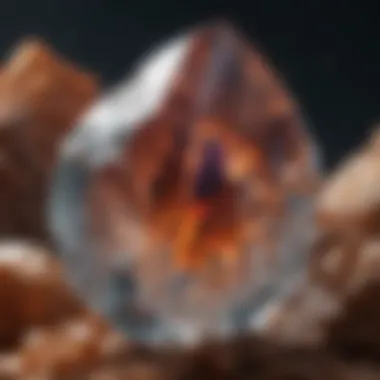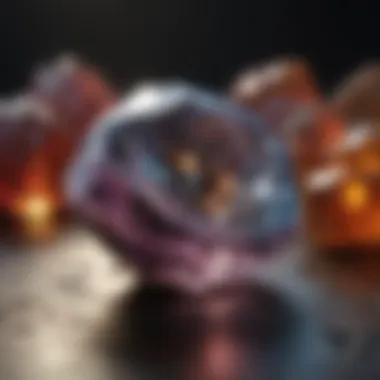Unveiling the Enchanting Realm of Gemstones, Rocks, and Crystals


Rock and Fossil Identificatoin
Gemstones, rocks, and crystals capture the imagination with their enchanting allure. When it come's to rock and fossil identification, understanding the types of rocks and fossils is key, broadening one's perspective on the geological tapestry. Various characteristics manifest in these geological wonders, from intricate patterns to unique textures that are discernible with a keen eye. Employing tools for identification is essential in this pursuit, enabling enthusiasts to delve deeper into the world of mineralogy.
Collecting Tips and Techniques
For rock and fossil collectors looking to enhance their collection, adopting best practices holds significance. Exploring the prime collecting sites unlocks opportunities to unearth rare specimens, shaping a rewarding collecting experience. Safely extracting specimens requires precision and care, ensuring their integrity remains intact as they transition from the earth's embrace to the collector's hands.
Preservation and Display
Preserving rocks and fossils for posterity demands strategic techniques that safeguard their intrinsic beauty. Storing these geological treasures using proper methods maintains their integrity, shielding them from the ravages of time. As collectors seek to display their prized specimens, creative ideas come into play, accentuating the allure of these natural marvels in captivating arrangements.
Geological Insights
Delving into the geological insights garnered from gemstones, rocks, and crystals unveils a world steeped in historical significance. Exploring the formations and processes that shape these treasures provides a window into the earth's complex evolution. Moreover, the notable discoveries in the field serve as testaments to human endeavor, offering glimpses into the extraordinary depths of our geological knowledge.
Introduction to Gemstones, Rocks, and Crystals
In embarking on an exploration of gemstones, rocks, and crystals, we delve into an enthralling domain that captures the essence of geological wonders. This section serves as a gateway to a multifaceted world where natural beauty meets scientific intrigue. Gemstones, renowned for their allure and rarity, impart a sense of luxury and mystique. Rocks, the sturdy pillars of Earth's crust, hold within them tales of ancient landscapes and geological processes. Crystals, with their varied forms and unique properties, mesmerize with their symmetry and light refraction.
Understanding the Differences
Defining Gemstones
Gemstones, prized for their aesthetic appeal and durability, play a significant role in adornment and investment. The distinguishable factor of gemstones lies in their mineral composition and crystalline structure, granting them exceptional beauty and hardness. Their resilience against wear and ability to refract light make them highly sought after for jewelry and ornamental purposes.
Distinctive Features of Rocks
Rocks, the building blocks of landscapes, exhibit a wide range of textures, colors, and mineral compositions. Their formation through geologic processes like cooling magma and sediment accumulation gives them unique characteristics. From the rugged beauty of granite to the layered sedimentary patterns of sandstone, rocks provide insights into Earth's dynamic history.
Characteristics of Crystals
Crystals, with their symmetrical shapes and internal order, demonstrate a remarkable display of natural beauty. Their molecular structure influences their optical properties, leading to phenomena like pleochroism and internal reflections. From the faceted brilliance of diamonds to the delicate hues of amethyst, crystals enchant observers with their innate elegance.
Formation Processes
Metamorphic Processes
Metamorphic processes involve the transformation of existing rocks under extreme heat and pressure, resulting in new mineral alignment and texture. This metamorphism creates unique patterns and mineral compositions, showcasing the dynamic nature of Earth's crust.
Igneous Formation
Igneous rocks form from the solidification of molten magma, either deep within the Earth or during volcanic eruptions. The rate of cooling influences the crystal size and texture, giving rise to diverse igneous formations such as basalt and granite with varying mineral content.
Sedimentary Deposition
Sedimentary rocks form through the accumulation and compression of sediments over time. The layers in sedimentary rocks reveal clues about ancient environments and past climates. From the organic richness of shale to the calcium carbonate structures of limestone, sedimentary rocks provide a window into Earth's past.
Geological Significance
Impact on Earth's History
Gemstones, rocks, and crystals hold clues to Earth's geological past, acting as time capsules that preserve significant events and processes. Through the study of these geological materials, scientists can unravel the mysteries of Earth's formation and evolution over millennia.
Role in Plate Tectonics
Rocks and minerals serve as indicators of tectonic movements and plate interactions, aiding geologists in understanding the dynamics of the Earth's lithosphere. The distribution of specific minerals provides insights into the forces shaping Earth's surface, highlighting the interconnected nature of geological processes.
Indicator Minerals
Certain minerals act as indicators for valuable ore deposits or subsurface mineralization, guiding exploration efforts in mining and resource extraction. These indicator minerals reveal hidden geological resources, offering key insights for sustainable extraction practices and mineral resource management.


Cultural and Historical Perspective
Mythical Beliefs and Symbolism
Throughout history, gemstones, rocks, and crystals have held symbolic significance across various cultures and belief systems. Legends and myths often attribute mystical properties to these natural treasures, associating them with protection, wisdom, and spiritual enlightenment.
Archaeological Discoveries
Archaeological excavations have unearthed traces of ancient civilizations' uses of gemstones and rocks for ritualistic, ornamental, and practical purposes. These discoveries shed light on the artistic and technological achievements of past societies, revealing the enduring fascination with geological materials.
Royal and Ceremonial Uses
Gemstones and crystals have adorned royal regalia and ceremonial objects for centuries, signifying power, authority, and divine favor. The vibrant colors and pristine clarity of gemstones symbolize wealth and status, often becoming treasured heirlooms passed down through generations.
Utilization in Modern Society
Industrial Applications
In modern industries, gemstones, rocks, and crystals find applications in technology, construction, and manufacturing processes. Their hardness, heat resistance, and electrical properties make them invaluable materials for cutting tools, abrasives, and precision instruments.
Healing and Metaphysical Uses
Beyond their physical properties, gemstones and crystals are believed to possess metaphysical properties that can influence emotional and spiritual well-being. Many individuals use crystals for energy alignment, meditation, and holistic healing practices, attributing specific qualities to different gem varieties.
Ornamental Purposes
Gemstones and rocks continue to be cherished for their aesthetic appeal and cultural significance in modern society. From elegant jewelry pieces to decorative stone accents in architecture, these geological treasures enhance the visual allure of everyday objects, connecting us to the Earth's natural beauty.
Types and Varieties of Gemstones, Rocks, and Crystals
Gemstones, rocks, and crystals, inherent to Earth's magnificent tapestry, boast a diverse array of types and varieties, each possessing unique qualities and characteristics. In this article, the discussion surrounding these entities serves as a foundation for understanding geological wonders. By exploring the distinctive traits of gemstones, the solid structures of rocks, and the symmetrical formations of crystals, enthusiasts gain profound insights into the essence of these geological components.
Rare Gemstones
Alexandrite
Exuding an exuberant allure, Alexandrite stands as a beacon of rarity and elegance within the realm of gemstones. With its mesmerizing color-changing properties, shimmering from emerald green to vibrant red under varying light conditions, Alexandrite captivates the beholder with its mystique. Its scarcity in nature invokes a sense of exclusivity, making it a coveted choice for collectors and connoisseurs alike. However, the challenges in procuring high-quality Alexandrite intensify its allure in the gemstone market.
Taaffeite
Taaffeite, a gem of understated elegance, contributes a touch of sophistication to the spectrum of rare gemstones. Renowned for its stunning purplish hues and limited occurrence in nature, Taaffeite holds a distinctive appeal for those seeking unconventional beauty in gemstone treasures. Its unique composition and rarity elevate its desirability, positioning Taaffeite as a prized possession among discerning enthusiasts.
Red Beryl
Epitomizing the exquisiteness of rare gemstones, Red Beryl dazzles with its fiery red brilliance, making it a true marvel of nature. Its scarcity rivals that of some of the rarest gemstones globally, elevating its status to that of a coveted collector's gem. Red Beryl's intense color saturation and scarcity propel it into the upper echelons of gemstone rarity, rendering it a symbol of exclusivity and luxury.
Sedimentary Rocks
Limestone
Limestone, a sedimentary rock of immense geological significance, cradles within its layers a record of ancient marine life and environmental changes. Its versatile nature allows for a myriad of applications, from construction materials to architectural masterpieces. The durability and aesthetic appeal of limestone make it a valuable asset in various industries, symbolizing a harmonious blend of natural beauty and practicality.
Sandstone
Sculpted by the passage of time, Sandstone emerges as a testament to the intricate dance between sedimentation and lithification. Its unique texture and color variations add a touch of rustic charm to architectural marvels and artistic creations. Sandstone's resilience and distinct aesthetic qualities render it a favored choice for both historical preservation projects and contemporary architectural designs.
Shale
Shale, a sedimentary rock formed from the gradual compression of mud and silt over eons, embodies a fascinating narrative of Earth's geological processes. Its fine-grained structure and propensity to retain organic matter make shale a key resource for energy production and environmental studies. The layers of shale unlock a chronicle of past climates and ecosystems, offering invaluable insights into geological history and natural resource exploration.
Crystal Structures
Cubic Crystals


Cubic crystals, showcasing a symmetrical arrangement of faces and vertices, embody a sense of geometric perfection in the world of crystals. Their uniform shape and distinct edges grant them a striking visual appeal, attracting enthusiasts and researchers alike. The clarity and brilliance of cubic crystals make them ideal subjects for scientific study and ornamental purposes, symbolizing precision and order in the natural world.
Hexagonal Crystals
Hexagonal crystals, characterized by six-sided symmetry and prism-like structures, exude a delicate balance of beauty and symmetry in their formation. The inherent symmetry of hexagonal crystals imparts a sense of harmony and stability, making them popular choices for jewelry and decorative pieces. Their elegance and natural allure spark fascination among collectors and gemstone enthusiasts, contributing to the diverse tapestry of crystal formations.
Monoclinic Crystals
Monoclinic crystals, distinguished by their asymmetric prismatic shapes and inclined crystal axes, offer a glimpse into the intriguing world of crystallography. Despite their asymmetrical form, monoclinic crystals possess unique optical properties and structural characteristics that make them valuable subjects for research and lapidary craftsmanship. The versatility and complexity of monoclinic crystals add depth to the study of crystallography, enriching our understanding of crystalline structures and mineral compositions.
Popular Gemstones
Diamond
Diamonds, revered for their unparalleled brilliance and hardness, reign as symbols of enduring love and timeless elegance in the world of gemstones. Their remarkable optical properties and durability place them at the pinnacle of coveted gemstones, desired for both their aesthetic beauty and inherent value. From jewelry adornments to industrial applications, diamonds continue to captivate hearts and minds, symbolizing resilience and refinement in the gemstone hierarchy.
Emerald
Emeralds, coveted for their verdant hues and lush internal landscapes, embody the essence of nature's beauty and vitality within the realm of gemstones. The vivid green tones and natural inclusions of emeralds underscore their authenticity and allure, capturing the essence of lush landscapes and bountiful flora. Their association with luxury and prosperity elevates emeralds to a status of opulence and sophistication, making them cherished treasures among gemstone aficionados.
Sapphire
Sapphires, renowned for their velvety blues and vibrant hues across the color spectrum, enchant admirers with their celestial charm and regal allure. As symbols of sincerity and wisdom, sapphires evoke a sense of serenity and divine connection, resonating with both historical significance and contemporary appeal. Their versatility in jewelry design and mystical associations solidify sapphires as enduring symbols of beauty and spirituality, embodying the allure of the celestial realms within the confines of a gemstone.
Properties and Characteristics
In the vast world of gemstones, rocks, and crystals, understanding their properties and characteristics is paramount. These features play a vital role not only in identification but also in determining their value and utility. One cannot underestimate the significance of these attributes when delving into the fascinating realm of geological wonders. Properties such as color, transparency, hardness, and light interaction contribute to the allure and versatility of these gemological treasures.
Color and Transparency
Gemstone Coloration
Gemstone coloration is a crucial aspect that defines the aesthetic appeal and market value of gemstones. The richness of color, whether vibrant or subtle, enhances the beauty of these natural formations. Each hue represents a combination of trace elements and structural defects within the crystal lattice. Gemstone coloration influences not only their visual attractiveness but also their rarity and symbolic significance. Understanding the nuances of coloration is essential for gemstone enthusiasts, collectors, and traders.
Translucency vs. Opacity
The translucency or opacity of gemstones defines their ability to transmit light. Transparent gems allow light to pass through with minimal distortion, creating a captivating play of colors. In contrast, opaque gemstones absorb light, showcasing deeper and more intense hues. The choice between translucency and opacity depends on the desired visual effect and the gemstone's inherent properties. Balancing translucency and opacity is an art in jewelry design and gemstone selection.
Crystal Clarity
The clarity of gemstones refers to the presence of inclusions, fractures, or blemishes within the crystal structure. Clarity significantly impacts the gem's brilliance and light performance. A flawless gem with high clarity commands a premium price due to its rarity and visual appeal. Gemologists meticulously assess crystal clarity using magnification tools to classify gems based on their purity and internal characteristics. Understanding crystal clarity is crucial for both evaluating gem quality and appreciating their natural beauty.
Hardness and Durability
Mohs Scale of Hardness
The Mohs Scale of Hardness, developed by Friedrich Mohs in 1812, ranks minerals based on their scratch resistance. This scale determines the relative hardness of gemstones, with diamond being the hardest mineral at the top of the scale. Understanding a gem's hardness is essential for determining its wearability, resistance to abrasion, and suitability for different types of jewelry settings. Jewelers and gem enthusiasts rely on the Mohs Scale for assessing gem durability and ensuring proper care and maintenance.
Cleavage and Fracture
Cleavage and fracture are critical factors that influence a gemstone's durability and susceptibility to damage. Cleavage refers to the tendency of a mineral to break along certain planes due to the arrangement of its atoms. Fracture, on the other hand, describes the way a gem breaks when subjected to external force. Evaluating cleavage and fracture helps gemologists understand the structural integrity of a gem and determine the best practices for handling and setting it securely.
Scratch Resistance
The scratch resistance of gemstones plays a crucial role in maintaining their pristine beauty over time. Gems with high scratch resistance are less likely to be marred by everyday wear and tear. Understanding a gem's scratch resistance properties allows owners to handle and wear their jewelry with confidence. Jewelers often educate customers on proper care routines to preserve the longevity and luster of their precious gemstone possessions.
Light Interaction
Refraction and Dispersion
Refraction and dispersion are optical phenomena that define how light interacts with gemstones, creating dazzling visual effects. Refraction occurs when light enters a gemstone and bends, highlighting its brilliance and sparkle. Dispersion refers to the separation of white light into spectral colors, commonly seen in gems such as diamonds and sapphires. Mastering the art of refraction and dispersion is essential for appreciating the unique beauty and fire displayed by different gem varieties.


Pleochroism
Pleochroism is a fascinating optical property exhibited by certain gemstones, wherein they display different colors when viewed from different angles. This phenomenon adds depth and complexity to the gem's visual appearance, captivating the beholder with its ever-changing hues. Gem enthusiasts value pleochroic gems for their dynamic nature and the mesmerizing effect they create when shifting under varying light conditions.
Luster and Brilliance
The luster and brilliance of a gemstone encapsulate its shine and reflective qualities, contributing to its overall beauty and allure. Luster refers to the surface appearance of a gem, showcasing its smoothness and polish. Brilliance, on the other hand, pertains to the gem's ability to reflect light and sparkle. Balancing luster and brilliance is key in gemstone selection and jewelry design to create pieces that exude elegance and sophistication.
Specific Gravity and Density
Measurement Techniques
Accurately measuring the specific gravity and density of gemstones is crucial for identification, characterization, and differentiation. Gemologists utilize various techniques such as hydrostatic weighing and displacement method to determine a gem's density. Understanding the specific gravity of a gem aids in discerning its authenticity, as different gem types exhibit varying density values. Precision in measurement techniques ensures accurate gem identification and assessment for gemological studies and valuation.
Variability in Densities
The variability in densities among gemstone varieties offers valuable insights into their composition and formation processes. Diverse gem types have distinct density ranges influenced by their chemical composition, crystal structure, and formation environment. Recognizing the variability in densities is essential for gem identification and classification, enabling gem experts to differentiate between similar-looking gemstones based on their distinct density profiles.
Significance in Identification
The specific gravity and density of gemstones serve as unique identifiers, aiding gemologists in distinguishing between natural and synthetic gem materials. By comparing a gem's density to known values in gemological databases, experts can authenticate gems and prevent misrepresentation in the market. The significance of density in identification extends to gemstone treatments and enhancements, where alterations can affect the gem's overall density profile, leading to clues for detection and evaluation.
This detailed exploration of the properties and characteristics of gemstones, rocks, and crystals provides a comprehensive foundation for understanding the complexities and beauty of these geological treasures. By delving deep into the multifaceted nature of gemological features, enthusiasts can enrich their knowledge and appreciation for the captivating world of gemstones and minerals.
Collection and Preservation Techniques
Collection and preservation techniques play a pivotal role in this article about gemstones, rocks, and crystals. Understanding how to ethically source and maintain these geological treasures is essential for both conservation and appreciation of their beauty and value. The meticulous curation of specimens ensures their longevity and integrity for future generations of rock and fossil enthusiasts. In the following subsections, we delve into the significance of ethical sourcing practices, cleaning, maintenance, and display considerations.
Ethical Sourcing Practices
Conflict-Free Origins
Diving into the realm of conflict-free origins unveils a critical aspect of ethical sourcing. By prioritizing this facet, the article can shed light on the importance of promoting sustainable practices within the industry. Conflict-free origins guarantee that gemstones, rocks, and crystals are procured in a manner that minimizes harm and supports communities. Exploring the meticulous processes involved in conflict-free mining adds a layer of depth to our understanding of these geological marvels. Despite certain challenges, the resounding benefits of advocating for conflict-free sourcing resonate throughout the narrative.
Sustainable Mining
Discussing sustainable mining offers a nuanced perspective on the environmental impact of geological extraction. In this context, the focus shifts towards practices that ensure minimal ecological disruption while meeting the demands of the market. By emphasizing sustainable mining practices, the article underscores the industry's transitioning landscape towards eco-conscious methodologies. Highlighting the efficacy and limitations of such approaches provides readers with a holistic view of the field's ethical considerations.
Fair Trade Standards
Exploring fair trade standards introduces a framework of transparency and equity within the sourcing process. By delving into the complexities of fair trade, the article illuminates the significance of advocating for just compensation and dignified working conditions for laborers. The exploration of fair trade standards adds a human-centric dimension to the narrative, offering readers insights into the interconnectedness of ethical sourcing practices and social responsibility.
Cleaning and Maintenance
Gentle Cleaning Methods
Detailing gentle cleaning methods underscores the delicate nature of preserving gemstones, rocks, and crystals. By elaborating on specific techniques that ensure minimal abrasion and damage, the narrative equips readers with practical knowledge for maintaining their collections. Emphasizing the importance of gentle cleaning not only prolongs the lifespan of specimens but also enhances their aesthetic appeal and scientific value.
Preventing Damage
Addressing methods to prevent damage accentuates the proactive approach required in safeguarding geological samples. By highlighting strategies to mitigate risks during handling and storage, the article fosters a culture of care and conservation among enthusiasts. Exploring the nuances of damage prevention enriches the reader's understanding of the fragility inherent in these natural artifacts, thereby elevating the discourse on responsible collection management.
Long-Term Storage
Delving into long-term storage techniques delves into the archival aspects of rock and crystal preservation. By elucidating best practices for maintaining specimens over extended periods, the article instills a sense of stewardship among collectors. Discussing the intricacies of long-term storage not only safeguards the integrity of specimens but also contributes to the academic and historical significance of geological archives.
Display and Exhibition
Lighting Considerations
Unveiling the nuances of lighting considerations uncovers the artistry behind showcasing gemstones, rocks, and crystals. By examining the interplay of illumination and composition, the narrative offers insights into enhancing the visual impact of geological displays. Emphasizing the role of lighting in accentuating textures and hues adds a layer of sophistication to the discourse on exhibiting these natural wonders.
Mounting and Presentation
Exploring mounting and presentation techniques accentuates the craftsmanship involved in curating immersive exhibitions. By delving into methods that elevate the aesthetic presentation of specimens, the article inspires readers to appreciate the artistry inherent in showcasing geological collections. Discussing innovative approaches to mounting and presentation fosters a deeper connection with the materiality and beauty of gemstones, rocks, and crystals.
Preservation from Environmental Factors
Investigating strategies for preserving specimens from environmental factors underscores the need for proactive conservation measures. By outlining methods to shield geological samples from degradation and decay, the article advocates for the longevity and accessibility of these valuable resources. Exploring the intersection of preservation and environmental stewardship enriches the narrative with a sense of urgency and commitment to safeguarding our geological heritage.







